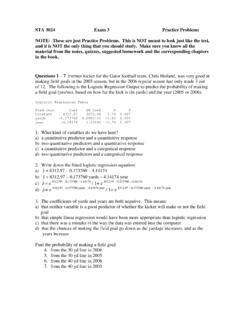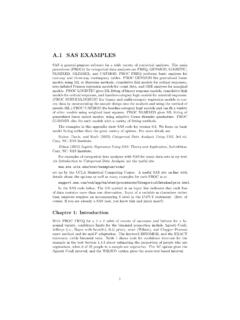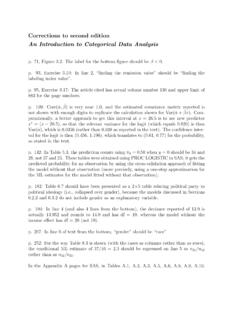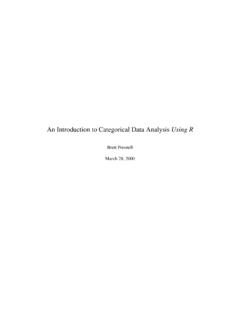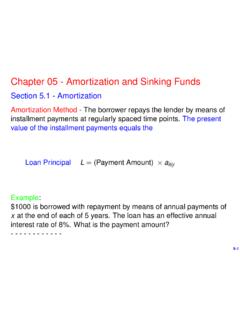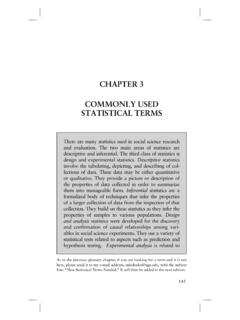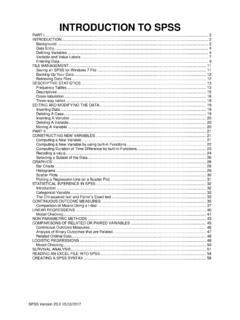Transcription of Introduction to Biostatistics - University of Florida
1 Introduction to BiostatisticsLarry WinnerDepartment of StatisticsUniversity of FloridaJuly 8, 20042 Contents1 Populations and Samples .. Types of Variables .. Quantitative vs Qualitative Variables .. Dependent vs Independent Variables .. Parameters and Statistics .. Graphical Techniques .. Basic Probability .. Diagnostic tests .. Basic Study Designs .. Observational Studies .. Experimental Studies .. Other Study Designs .. Reliability and Validity .. Exercises .. 312 Random Variables and Probability The Normal Distribution .. Statistical Models .. Sampling Distributions and the Central Limit Theorem .. Distribution ofY.. Exercises .. 403 Statistical Inference Hypothesis Introduction to Hypothesis Testing.
2 Large Sample tests Concerning 1 2(Parallel Groups) .. Elements of Hypothesis tests .. Significance Level of a Test (Size of a Test) .. Power of a Test .. Sample Size Calculations to Obtain a Test With Fixed Power .. Small Sample tests .. Parallel Groups Designs .. Crossover Designs .. Exercises .. 594 Statistical Inference Interval Large Sample Confidence Intervals .. Small Sample Confidence Intervals .. Parallel Groups Designs .. Crossover Designs .. Exercises .. 695 Categorical Data 2 2 Tables .. Relative Risk .. Odds Ratio .. Extension tor 2 Tables .. Difference Between 2 Proportions (Absolute Risk) .. Small Sample Inference Fisher s Exact Test.
3 McNemar s Test for Crossover Designs .. Mantel Haenszel Estimate for Stratified Samples .. Nominal Explanatory and Response Variables .. Ordinal Explanatory and Response Variables .. Nominal Explanatory and Ordinal Response Variable .. Assessing Agreement Among Raters .. Exercises .. 916 Experimental Design and the Analysis of Completely Randomized Design (CRD) For Parallel Groups Studies .. Test Based on Normally Distributed Data .. Test Based on Non Normal Data .. Randomized Block Design (RBD) For Crossover Studies .. Test Based on Normally Distributed Data .. Friedman s Test for the Randomized Block Design .. Other Frequently Encountered Experimental Designs .. Factorial Designs.
4 Crossover Designs With Sequence and Period Effects .. Repeated Measures Designs .. Exercises .. 1197 Linear Regression and Least Squares Estimation of 0and 1.. Inferences Concerning 1.. Correlation Coefficient .. The Analysis of Variance Approach to Regression .. Multiple Regression .. Testing for Association Between the Response and the Set of ExplanatoryVariables .. Testing for Association Between the Response and an Individual ExplanatoryVariable .. Exercises .. 1448 Logistic and Nonlinear Logistic Regression .. Nonlinear Regression .. Exercises .. 1589 Survival Estimating a Survival Function Kaplan Meier Estimates .. Log Rank Test to Compare 2 Population Survival Functions.
5 Relative Risk Regression (Proportional Hazards Model) .. Exercises .. 17110 Special Topics in Assessment of Pharmaceutical Bioequivalence .. Dose Response Studies .. Exercises .. 183A Statistical Tables187B Bibliography1936 CONTENTSC hapter 1 IntroductionThese notes are intended to provide the student with a conceptual overview of statistical methodswith emphasis on applications commonly used in pharmaceutical and epidemiological research. Wewill briefly cover the topics of probability and descriptive statistics, followed by detailed descriptionsof widely used inferential procedures. The goal is to provide the student with the information neededto be able to interpret the types of studies that are reported in academic journals, as well as theability to perform such analyses.
6 Examples are taken from journals in the pharmaceutical andhealth sciences Populations and SamplesApopulationis the set of all measurements of interest to a researcher. Typically, the populationis not observed, but we wish to make statements or inferences concerning it. Populations can bethought of are well defined sets of data containingelements that could be identified explicitly. Examples include:PO1CD4counts of every American diagnosed with AIDS as of January 1, of active drug in all 20 mg Prozac capsules manufactured in June or absence of prior myocardial infarction in all American males between 45 and 64years of are non existing, yet visualized, or imaginable, sets of measurements. Thiscould be thought of characteristics of all people with a disease, now or in the near future, forinstance.
7 It could also be thought of as the outcomes if some treatment were given to a large groupof subjects. In this last setting, we do not give the treatment to all subjects, but we are interestedin the outcomes if it had been given to all of them. Examples include:PO4 Bioavailabilities of a drug s oral dose (relative to i. v. dose) in all healthy subjects underidentical or absence of myocardial infarction in all current and future high blood pressurepatients who receive short acting calcium channel 1. INTRODUCTIONPO6 Positive or negative result of all pregnant women who would ever use a particular brand ofhome pregnancy observed sets of measurements that are subsets of a corresponding are used to describe and make inferences concerning the populations from which they methods are based on these samples having been taken at random from the , in practice, this is rarely the case.
8 We will always assume that the sample is representativeof the population of interest. Examples include:SA1CD4counts of 100 AIDS patients on January 1, of active drug in 2000 20 mg Prozac capsules manufactured during June myocardial infarction status (yes or no) among 150 males aged 45 to 64 of an oral dose (relative to dose) in 24 healthy or absence of myocardial infarction in a fixed period of time for 310 hypertensionpatients receiving calcium channel results (positive or negative) among 50 pregnant women taking a home pregnancy Types of Quantitative vs Qualitative VariablesThe measurements to be made are referred to asvariables. This refers to the fact that weacknowledge that the outcomes (often referred to asendpointsin the medical world) will varyamong elements of the population.
9 Variables can be classified asquantitative(numeric) orqualitative(categorical). We will use the terms numeric and categorical throughout this text, since quantitativeand qualitative are so similar. The types of analyses used will depend on what type of variable isbeing studied. Examples include:VA1CD4count represents numbers (or counts) ofCD4lymphocytes per liter of peripheral blood,and thus amount of active drug in a 20 mg Prozac capsule is the actual number of mg of drugin the capsule, which isnumeric. Note, due to random variation in the production process,this number will vary and never be exactly myocardial infarction status can be classified in several ways. If it is classified as eitheryes or no, it iscategorical. If it is classified as number of prior MI s, it , numeric variables can be broken into two types:continuousanddiscrete.
10 Continuousvariables are values that can fall anywhere corresponding to points on a line segment. Someexamples are weight and diastolic blood pressure. Discrete variables are variables that can take ononly a finite (or countably infinite) number of outcomes. Number of previous myocardial TYPES OF VARIABLES9and parity are examples of discrete variables. It should be noted that many continuous variablesare reported as if they were discrete, and many discrete variables are analyzed as if they , categorical variables also are commonly described in one of two ways:nominalandordinal. Nominal variables have distinct levels that have no inherent ordering. Hair color andsex are examples of variables that would be described as nominal. On the other hand, ordinalvariables have levels that do follow a distinct ordering.



